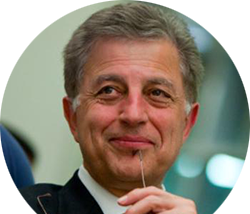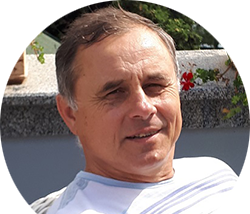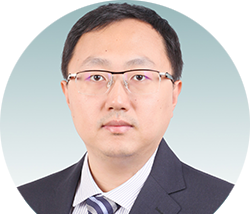Topics
- General Mechanics
- Fluid Mechanics
- Mechanics of Solid Bodies
- Biomechanics
- Control and Robotics
- Interdisciplinary and Multidisciplinary Problems
Mini-Symposia
- MS1: Mechanical Metamaterials
Organizers: Milan Cajić, Mathematical Institute SANU, Serbia; Danilo Karličić, Mathematical Institute SANU, Serbia - MS2: Turbulence
Organizer: Đorđe Čantrak, University of Belgrade, Serbia
Plenary Speakers:
1. Prof. Dr. Parviz Moin – Center for Turbulence Research, Stanford University, California, USA
Title: Probing Turbulence Physics Using Numerical Simulation Databases – A Case Study in Predictive Science
2. Prof. Dr. Nikolay Nikitin – General Aerodynamics Laboratory, Institute of Mechanics, Lomonosov Moscow State University, Russia
Title: Secondary Flows of Prandtl’s Second Kind. Mechanism of Formation and Method of Prediction
3. Prof. Dr. Ji Pei – National Research Center of Pumps, Jiangsu University, China
Title: Research on High Efficiency and High Reliability Pumps in Jiangsu University - MS3: Biomechanics and Mathematical Biology
Organizers: Andjelka Hedrih, Mathematical Institute of Serbian Academy of Sciences and Arts, Serbia; Marat Dosaev, Lomonosov Moscow State University, Moskva, Russian Federation
Plenary Speakers:
1. Prof. Dr. Su Fong-Chin – Department of Biomedical Engineering, College of Engineering, National Cheng Kung University, Tainan, Taiwan; Medical Device Innovation Center, National Cheng Kung University, Tainan, Taiwan
Title: An Exergame-Integrated IoT-Based Ergometer System for Personalized Training of the Elderly
2. Prof. Dr. Marco Amabili – Department of Mechanical Engineering, McGill University, Montreal, Canada
Title: Effect of Smooth Muscle Activation in the Static and Dynamic Mechanical Characterization of Human Aortas - MS4: Nonlinear Dynamics
Organizer: Julijana Simonović, Faculty of Mechanical Engineering University of Niš, Serbia
Mini-Symposia - Plenary Speakers
Mini-Symposium II - Turbulence
Prof. Dr. Parviz Moin
Center for Turbulence Research, Stanford University, California, USA
Title: Probing Turbulence Physics Using Numerical Simulation Databases – A Case Study in Predictive Science

Abstract:
With the exponential growth in computer power, high fidelity numerical simulations have provided unprecedented comprehensive datasets for the study of the mechanics of turbulent flows. A brief review of fundamental research on the structure of wall-bounded turbulent flows will be presented with particular emphasis on the role played by large scale numerical simulations in conducting controlled experiments of discovery and the insights gained as a result. On the other hand, the early promise of direct numerical simulations to provide data to improve engineering models has not been fulfilled. I will expand on this in the context of lessons learned of the limitations of data science in the development of physical models.
Biography:
Parviz Moin is the Franklin and Caroline Johnson Professor in the School of Engineering at Stanford University. He is the founding director of the Center for Turbulence Research, CTR, at Stanford University. CTR is widely recognized as the international focal point for turbulence research.
Professor Moin pioneered the use of direct and Large Eddy Simulation techniques for the study of turbulence physics, control and modelling concepts and has written widely on the structure of turbulent shear flows. His current interests include: large eddy simulation of complex flows, multi-phase flows with application to aircraft icing, hypersonic flows, propulsion, computational science, and flow control. He is a co- Editor of the Annual Review of Fluid Mechanics and Associate Editor of Journal of Computational Physics. Professor Moin is a member of the U.S. National Academy of Sciences, and the National Academy of Engineering. He is a Fellow of the American Academy of Arts and Sciences, AIAA and APS.
More information about the teaching and publications on the LINK.
Prof. Dr. Nikolay Nikitin
General Aerodynamics Laboratory, Institute of Mechanics, Lomonosov Moscow State University, Russia
Title: Secondary Flows of Prandtl’s Second Kind. Mechanism of Formation and Method of Prediction

Abstract:
The paper formulates a mechanism that makes it possible to explain and, in some cases, predict the shape of secondary flows of Prandtl’s second kind arising in turbulent flows in straight pipes of non-circular cross-section [1-3]. The secondary flows are consistent with the distribution of mean pressure along the perimeter of the cross section. In the section of the boundary between the neighboring points of the local maximum and minimum pressure, the fluid particles must move along the boundary in the direction from higher pressure to lower. This is because there are no Reynolds stresses on the solid wall, and the pressure force can only be balanced by viscous friction force acting against the direction of the motion. In some cases, the location of local pressure extremes along the perimeter of the pipe cross-section can be determined based on the analysis of the curvature of the boundary. Fluctuating motion along a curved trajectory along the boundary causes a change in pressure on the wall the greater the greater the curvature of the boundary. There is an increase in pressure on the concave sections of the boundary, and on the convex, on the contrary, there is a decrease. A number of examples known from the literature confirm the effectiveness of the proposed principle. Among them are the flows in a pipe of square cross-section [4], in a pipe of elliptical cross-section [5], in pipes with a cross-section in the form of a circular sector with different apex angles, in rectangular pipes with rounded corners [6], in an eccentric annular pipe [7]. In most cases, an approximate picture of secondary flows can be predicted a priori, using only symmetry considerations and analysis of the curvature of the cross-section boundary.
The conditions of the formulated mechanism are violated near free boundaries, where, in addition to the pressure gradient, tangential stresses also act on the fluid particles and the result of their competition is unknown in advance. The paper presents the results of direct numerical simulation of turbulent flows in rectangular channels containing free boundaries, demonstrating and explaining the features of secondary flows in these cases.
The results of this work provide a rational basis for understanding the reasons for the formation and prediction of the shape of secondary flows of Prandtl’s second kind arising in straight pipes of non-circular cross-section.
The work was carried out with the financial support of the RNF, project No. 22-21-00184.
Biography:
Doctor of Science Nikolay Vasilyevich Nikitin is the author of more than 80 journal publications, of which 32 have been published in Q1 journals.
In 1979 he graduated from the Faculty of Mechanics and Mathematics of Moscow State University. In 1985 he defended his PhD thesis under the supervision of academician G.I. Petrov. In 1998 he became a doctor of Physical and mathematical Sciences. Since 2001, he has been working at the Institute of Mechanics of Moscow State University, since 2009 as head of the Laboratory of General Aerodynamics.
The main areas of scientific activity of N.V. Nikitin: the development of methods for the numerical solution of the Navier-Stokes equations, the study of turbulent flows of incompressible fluid and unsteady gas dynamic processes.
Twice, in 1995 and 1998, he was awarded the prize of the editorial board of the journal Izvestia of Russian Academy of Sciences, MZHG (Fluid Dynamics journal) and the publishing house “Plenum Publishing Corporation” for the best publications of the year. In 1996, the Presidium of the Academy of Natural Sciences awarded N.V. Nikitin a commemorative medal of the Academy dedicated to P.L. Kapitsa for the development of methods for direct simulation of turbulent flows. The Presidium of the National Committee for Theoretical and Applied Mechanics of the Russian Academy of Sciences in 1998 awarded N.V. Nikitin the academician G.I. Petrov Prize “For outstanding work in the field of the theory of hydrodynamic stability and turbulence” and in 2016 the award named after academician L.I. Sedov “For outstanding achievements in the field of fluid mechanics and general fundamentals of continuum mechanics”. In 2001, N.V. Nikitin was elected a member of the Russian National Committee for Theoretical and Applied Mechanics. Under his supervision, 6 PhD theses were defended.
Prof. Dr. Ji Pei
National Research Center of Pumps, Jiangsu University, China
Title: Research on High Efficiency and High Reliability Pumps in Jiangsu University

Abstract:
Rotodynamic pump, the most widely used pump machinery in the world, is a kinetic machine in which energy is continuously imparted to the pumped fluid by means of a rotating impeller. According to the forms of impeller, this kind of pump can be divided into three types: centrifugal, mixed-flow and axial-flow pump. Rotodynamic pumps can be used in almost every social and industrial areas, such as urban drainage, agricultural engineering, water conservancy, energy industry, petrochemical industry, coal industry, metallurgy, aerospace, shipbuilding and marine engineering, et al. Efficiency and reliability are the most important key factors to evaluate the pump overall performance, which need to be considered during design, manufacture and research process. It is involved in several academic fields, like complex fluid dynamics, bubble dynamics, structure dynamics and optimization algorithm, et al., therefore, the basic theory and its application for high efficiency and high reliability rotodynamic pumps are the current research focuses, which have very important academic significance. In this presentation, the research work on High Efficiency and High Reliability Pumps by the National Research Center of Pumps in Jiangsu University, China will be briefly introduced. Several key methods and technologies considering hydraulic design and optimization, cavitation suppression as well as monitoring and diagnosis will be included, and the real application cases, such as pumping station, two-phase flow pump, nuclear power pump, chemistry and oil industry pump, and water-saving irrigation equipment, will be involved.
Biography:
Dr. Ji Pei is a full professor and vice director in National Research Center of Pumps at Jiangsu University, China. He received a Ph.D. in Power Engineering and Engineering Thermophysics from Jiangsu University in 2013.During Ph.D. study, he also visited Chair for Turbomachinery at University of Duisburg-Essen, Germany for joint research. From October 2015 to January 2016, he was a DAAD Visiting Scholar in Institute of Fluid Mechanics and Fluid Machinery at TU Kaiserslautern, Germany, and from October 2016 to August 2017, he was a Visiting Scholar in Department of Industrial Engineering at University of Padova, Italy. Dr. Pei has been conducting research towards unsteady flow, multiphase flow in pumps, intelligent optimization for pumps, transient processes and multi-physics field coupling in fluid machinery. He was winner of Edwin Walker Prize by the Institution of Mechanical Engineers (IMechE, UK) in 2020, and Young Engineer Award by Asian Fluid Machinery Committee in 2017, and was invited as plenary speakers and session chairs in international conferences such as IAHR-AWG Symposium on Hydraulic Machinery and Systems, International Conference on Cavitation and Multiphase Flow, Asian Workshop on Hydraulic Machinery and Sino-German Scientific Symposium, et al. Dr. Pei has published more than 50 academic journal papers, and is current served as peer-reviewers for important international journals such as Proceedings of the Institution of Mechanical Engineers, Part A, Journal of Power and Energy, Engineering Optimization, Engineering Applications of Computational Fluid Mechanics, Journal of Fluids Engineering-Transactions of the ASME, Energy, Renewable Energy, Ocean Engineering and International Journal of Numerical Methods for Heat and Fluid Flow, et al.

